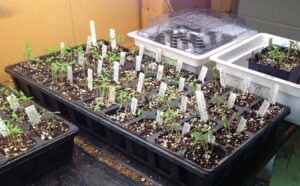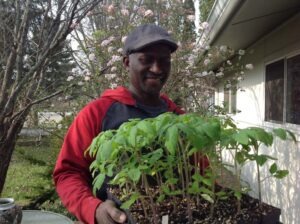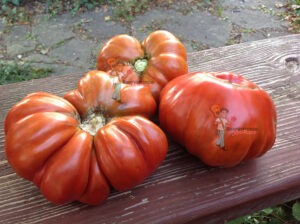Heirloom Tomato Seed Saving From Start To Finish
For about 30 years I have been saving heirloom and open pollinated tomato seeds. I have also harvested other varieties of fruits and vegetable seeds. But tomatoes have totally captivated and consumed me. Needless to say, I have saved and shared thousands of varieties of seeds. Here is how I go through my routine of heirloom tomato seed saving from start to finish.
The most important part of successful seed saving, especially if you are doing it on a larger scale, is planning. Better planning produces better results and fewer mistakes. I grow and save about 200 varieties each year. So avoiding confusion is always of importance. This is not to say that I haven’t had my share of mix-ups, but I do my best to keep accidents to a minimum. Before I continue, if you should ever have any doubts about a particular batch of seeds, safest way to deal with that is to note what you think it may be, so you could once again grow them out and see what they produce. Don’t Send Seeds Out If You Have Doubts! This would be the best thing, especially if your are selling or sharing seeds. Sending out the wrong seeds to a customer or trader is not cool!
Selecting And Labeling Your Starter Flats Or Cells.
 A large part of my seed saving planning, ironically, starts with the seed. I always make sure that the seeds which I start, came form the accurate package. Carefully then, I make labels for my starting containers or cells. The seed starting date is included on each label. As busy as I am, I may forget to check for germination. If, after ample time I don’t have the desired germination results that I expected, I can always start again. So that is how date labeling plays an important part.
A large part of my seed saving planning, ironically, starts with the seed. I always make sure that the seeds which I start, came form the accurate package. Carefully then, I make labels for my starting containers or cells. The seed starting date is included on each label. As busy as I am, I may forget to check for germination. If, after ample time I don’t have the desired germination results that I expected, I can always start again. So that is how date labeling plays an important part.
I sometimes use a written diagram if I am starting seeds in a multi-celled flat with various different varieties. This serves as a backup in case one of my labels are lost. I draw each cell as a square and write the names of each corresponding variety in it’s respective square. So I have a map of the starting tray. Once your seedlings have sprouted and ready to be planted, the same system should be followed. If everything is labeled you should be fine. Remember, the main goal is to harvest and save accurate cultivars.
Label Your Tomato Plants As You Transplant Them In The Garden.
 As important as any step, the continuance of labeling as plants are transplanted in the garden, will eventually make your life much easier. The labelling system that you use is perhaps as important as the labels that you do. They should be large enough to be easily found and be able to accommodate text that is large enough to be easily read. Please use a marker and materials that wouldn’t run or easily fade. Anything wood based would not work. I like using pencils on white labels that are plastic based. These, to me, have the longest life. More often than not, pencil never fades all season long. Some gardeners use Sharpie markers, but they eventually fade.
As important as any step, the continuance of labeling as plants are transplanted in the garden, will eventually make your life much easier. The labelling system that you use is perhaps as important as the labels that you do. They should be large enough to be easily found and be able to accommodate text that is large enough to be easily read. Please use a marker and materials that wouldn’t run or easily fade. Anything wood based would not work. I like using pencils on white labels that are plastic based. These, to me, have the longest life. More often than not, pencil never fades all season long. Some gardeners use Sharpie markers, but they eventually fade.
Using Bloom Bags To Ensure Pure Seeds
Most tomato seed savers do not protect their blooms from insect pollination. This is simply because many feel that the time is not worth the risk. Some knowledgable tomato growers estimate that the chances of cross pollination without protection is about 10% I have no way of verifying that. But I would think that it varies from location to location and year to year. My garden are around barns and many trees, and the bids are busy feeding on insects. As a result I rarely see pollinating insects in my garden. I have never had any issues or complaints with cross pollination, but I sometimes use bloom bags for my very first set of blooms. Pure seed is of most importance for the continuance of that cultivar.
One Very Important Practice For Seed Savers
One very important thing that I have learned, is never to plant two similar looking varieties next to each other if I plan on saving seeds. When your vines start entangling (and they will), similar varieties could be very difficult to identify. So perhaps you could plant a yellow next to a red, large beefsteak next to a cherry and black next to green etc.
 Once your tomatoes have started ripening and you have started harvesting them, labeling, once again, plays a very important part. I harvest 30 or 40 varieties in one picking. Much care is always taken that I have the right varieties labeled correctly. I take plastic baggies(but you can take anything) down the isles. I also take sticky labels with me down the rows. As I place each variety in a bag, it is labeled with its respective name. Some people write the variety name on the tomatoes. I don’t, because I wanna consume clean organic food. Writing can work though, if you are harvesting a small amount. Bags are secured and taken out of the garden. Now it’s tomato to harvest seeds. Yep, it’s one of my favorite parts of growing tomatoes. Continue reading Heirloom Tomato Seed Saving From Start To Finish HERE!
Once your tomatoes have started ripening and you have started harvesting them, labeling, once again, plays a very important part. I harvest 30 or 40 varieties in one picking. Much care is always taken that I have the right varieties labeled correctly. I take plastic baggies(but you can take anything) down the isles. I also take sticky labels with me down the rows. As I place each variety in a bag, it is labeled with its respective name. Some people write the variety name on the tomatoes. I don’t, because I wanna consume clean organic food. Writing can work though, if you are harvesting a small amount. Bags are secured and taken out of the garden. Now it’s tomato to harvest seeds. Yep, it’s one of my favorite parts of growing tomatoes. Continue reading Heirloom Tomato Seed Saving From Start To Finish HERE!





